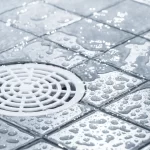Frozen pipes have been playing havoc on pipes since the invention of indoor plumbing. This problem often happens with pipes on the outside of your home or in cold spots throughout. Frozen pipes stop water from circulating in your home and might cause even burst. A burst pipe can cause thousands of dollars in water damage. If you suspect you have a frozen pipe, call a 24 hour emergency plumbing service as soon as possible.
It’s typical for homeowners to retreat to a warmer climate during the winter time. It may be a family vacation, or a business trip. For homeowners who forgot to heat their home during their absence frozen pipes can be a problem. It’s not uncommon for these homeowners to return to frozen or even burst pipes. Frozen pipes are especially a problem in the Toronto area due to our cold winter weather.
Today we’ll explain a few helpful tips on frozen pipes. How to figure out where your pipes frozen, how to thaw your frozen pipes, and how to prevent pipes from freezing.
Where Are Your Pipes Frozen?
There are a few areas where you will find most frozen pipes:
- In an unheated crawlspace or bulkhead near an exterior wall,
- any pipes located close to, or within, an exterior wall,
- pipes located beneath a sink and near, or within, an exterior wall,
- any pipes in a property that has not had heating during very cold weather.
Consider where the cold might be able to get to your pipe. Frozen pipes are always going to be in these locations.
If you’re very unlucky, you might have a pipe frozen inside of a wall. Look at your home from the outside and consider if it’s possible for the cold to freeze your pipes. You may need to remove sections of your interior wall to locate the problem. A professional plumber will be a big help in this process.
Now you know where to look for frozen pipes, when you have found one (that has not burst) what can you do?
How To Thaw Your Frozen Pipes?
First off, we recommend contacting a professional plumber to thaw your frozen pipes. It’s not a difficult task, but a mistake can lead to major plumbing problems. If you’d like to proceed on your own, do so with caution. Thawing pipes is a simple, but a little dangerous, so always thaw them with care.
Turn On The Water
Before you start, turn the water on for the section of pipe you are thawing. Flowing water will help to thaw the frozen section. After your is water on, you can start the thawing process.
Use A Heat Source
The best way to thaw your pipes is with a space heater, heat lamp or hair dryer. Place or hold the heater close to the pipe and thaw the length of the pipe. Do not try to secure the heat source to something or prop it up so you thaw it hands-free. This can lead to serious problems up to and including starting a fire. Instead, especially when using a hair dryer, you’ll need to stay with the pipe until it’s thawed.
Consider Heat Tape
Heat tape is one way to thaw frozen pipes you might want to consider. This tape wraps around your pipes and thaws them using a controlled thermostat. Best of all, it’s safe to leave on its own with regular inspections. After it’s done, you can unwrap the tape and your pipe will be completely thawed out.
Blowtorch? Just Say No
Yes, thawing pipes can take a long time. It’s not exciting work, sitting there with a hair dryer for what could be well over an hour, but it’s the safest method. Don’t use propane blowtorches or other high-heat equipment to thaw your pipes. You might set your house on fire or compromise the integrity of your pipes. Hot water inside your pipes is fine, but a blowtorch on the outside of the pipe is not.
How To Prevent Frozen Pipes?
After thawing your pipes you should look at ways to prevent water from freezing inside of them.
Increase Your Ambient Temperature
Increasing the temperature of your home a few degrees can make a big difference. If you’re finding frozen pipes on the inside of your home, keep your heating turned up. An increase of ambient temperature is the best way to solve the problem.
Open Cabinet Doors in Your Kitchen and Bathroom
Some homes have poor heat circulation, which can lead to frozen pipes in strange areas. Particularly where your water pipes are, the kitchen and bathroom.
In these homes, keep the thermostat above 20 degrees Celsius, even when you aren’t at home. If your frozen pipe was under a cabinet, open the cabinet during cold spells. This will help to keep heat circulating around the pipe, preventing it from freezing.
Close Your Garage Door
If you have pipes exposed in your garage you keep your garage door closed in the winter time.
Prevent Frozen Pipes When Away From Your Home
If you are planning a long absence from your home, consider your thermostat. It’s recommended to set it to at least 12 degrees Celcius.
Insulate Your Pipes
Consider your crawl spaces, attics, and basement. If there are pipes exposed in these areas insulation will be important to keep them heated. It’s a good idea to prevent drafts as well. Consider caulking to seal cracks in your windows, doors, and sill plates.
Can’t Insulate It? Open The Faucet
Exposed pipes that you can not protect from the are not a lost cause. Open the faucet on these exposed pipes enough for a trickle to flow. The water running through the pipe can help to prevent it from freezing.






